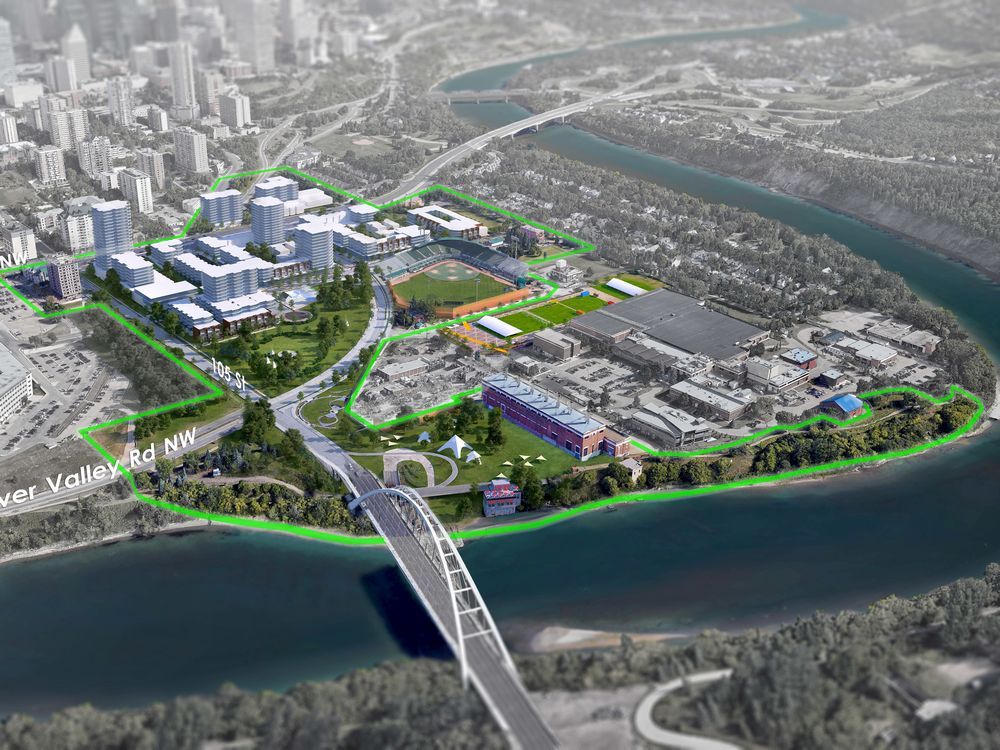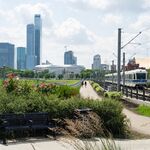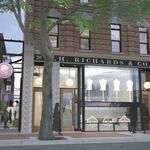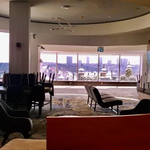Taking the features one at a time then...
1. An Amorphous Fabric Structure: Broadly covering most of the City-owned land and some of the Provincially-owned land in West Rostdale, the permanent structure could include:
i) a 3,000-seat amphitheatre-like auditorium for musical performances and a venue for story-tellers, comedians, spiritualists, solo performers, and speakers. The freeform roof would provide a light-weight structural solution whereby the “skin” would be a composite of grid-reinforced Texlon® ETFE (ethylene-tetra-fluoro-ethylene) with flexible Copper Indium Gallium DiSelenide (CIGS) photovoltaic cells laminated to the exterior surface in artful arrays and translucent aerogel laminated to the interior face. A separate “interior” structure (independent of the fabric roof) would provide a masting solution for air-handling systems, general and stage lighting, stage props, and acoustic sound baffles and absorbers. Superstructure tracks would enable portability and reconfigurability of most systems. Projection systems mounted on the interior structure framework would enable the use of the roof-underside and the audience seating area and wall enclosures — all — to become part of richly patterned display surfaces and motif-engendering art spaces for completely immersive experiences. Computer-generated art-forms developed by auditorium staff in concert with performers well in advance of performance dates would create unique experiences unlike any other facility in the world.
In support of the auditorium an onsite shop with state-of-the-art tools (including 3-d printers and CNC cutting/shaping machines), a fly loft with conventional drop curtains, a green-screen room with computer technology for scene creation, an orchestra pit, prop storage, costume storage, make-up rooms, sewing rooms, rehearsal space, dressing rooms, a blue room, projection screens, a proscenium arch, sets, a vomitory, wings, a sound room, a lighting room, a control room, a dance studio, a public wet bar, a public ante space and intermission room, offices, and restrooms — all — to create the most imaginative and reconfigurable facility with the latest in technology and appliances (including so-called 4-d tech for audience experiences). 4-d theatre tech would include the 21 (and growing) distinct effects that lead to an immersive audience experience, including theatre seat technology that enables all manner of motion possibilities (roll, sway and twist, pitch, heave, back shaker, bottom shaker, back tickler, bottom tickler, face air and air shots, and misting) as well as general room devices that include simulated rain, scents, warm air, wind, snow, lightning, rainstorm, fog , bubbles, and fog-storm effects. This theatre expression would be developed in concert with Copyright(c) CJ 4DPLEX.
ii) a 350-seat live theatre multifunctional performance stage with holographic capabilities. Like the larger theatre, there would be a sub-roof structural frame that provides manifold capacities vis-a-vis air handling, lighting, stage props, and sound manipulation and attenuation. And there would be 4DPLEX potentiality featured in both seating and the general interior environment. Again, the goal with the smaller theatre would be to create immersive experiences particularly aligned with Indigenous peoples’ spiritual contexts. Similar adjunct rooms to the larger venue — some shared; some unique unto the minor space — will fill out the vagaries of the performing arts.
iii) a large multipurpose space suitable for Pow Wows, Conventions, Potlatch Ceremonies and other Indigenous-specific functions. A substantial storage room adjacency will house furniture, fixtures and equipment that could then be placed as specific use demands. Here, the task would be to emulate an outdoor setting without the potential inclement exposure. Glass-walled nature spaces would surround the convention space with internal paths that connect to main entrances/exits. Within these atrium-like spaces several landscape idioms would be followed, including Alberta Parkland Woods (merging with an outdoor landscape), West-Coast Marine Rain Forest, Tropical Jungle, Desert Cliffs, and Prairie Grasslands. Some typical Fauna would also grace the interior space to highlight the connection to Nature — examples include: for Alberta Parkland Woods: thirteen-lined ground squirrels, snow-shoe hares, red squirrels, magpies, northern orioles, ruffled grouse, killdeers and yellow perch; West-Coast Marine Rain Forest: flying squirrels, chipmunks, blue grouse, warblers, and rainbow trout; Tropical Rainforest: three-toed sloth, northern tamandua, mangrove hummingbird, scarlet macaw, and tilapia; Desert Biome: desert cottontail, California rock lizard, desert tortoise, California quail, cactus wren, and desert sucker; Prairie Grasslands: black-tailed prairie dogs, Richardson’s ground squirrel, sharp-tailed grouse, greater prairie chicken, and white bass. The rationale for developing these limited species biomes surrounding the convention space, beyond creating a natural setting, is to underscore the reverence of nature that is typical in indigenous peoples’ lore, symbology, and hunter-gatherer ancient ways.
iv) Dining Rooms and Taverns. Part of the appeal of indigenous culture is the food and drink types that have become standards over the centuries of human existence. The World Indigenous Peoples’ Exposition intends to showcase these in major dining establishments and fashionable bars. Both antique food and drink types will sit along side modern concoctions. There would be 5 full-fledged dining rooms: one will represent prairie/north/eastern food types including meat, bird and fish dishes that highlight game — buffalo, elk, deer, caribou, arctic char, rainbow trout, partridge, and quail (all gathered from Edmonton-area suppliers); another would feature North American Coastal dishes — salmon, halibut, smelt, crab, sea weed, clams oysters and mussels; a third would feature central American food culture (Oaxacan) specialties including tamales, tortillas, atole, tejate, nicuatole, chocolate, sopa de piedra, chapulines, iguana eggs, nopales, and mole; the fourth culinary exposition would highlight Peruvian dishes — ceviche, lomo saltado, aji de gallina, papas a la huancaina, cuy, causa, rocoto relleno, anticuchos de corazon, arroz con pato, and pollo a la brasa; finally, a representation of Seminole cuisine rounds out the cultural aggregation of dining experiences — wild rice safki, bacon-hominy safki, sweet potato/pumpkin biscuits, skillet corn stuffing, fry bread, soaked corn gruel, cool shrimp salad, seared scallops with salsa, crab enchilada.
Drinks are equally varied and exotic relative to ‘western’ tastes. They fall into several broad categories — herbal and grass-based teas, coffees, fermented drinks and, separately, wines.
v) Fashion Runway and Indigenous Fashion Market. This represents an outlet for a burgeoning new field in Indigenous design, manufacture and cultural exposure. Very creative expressions are coming to the forefront of aboriginal fashion design and haute couture. To regularly offer an outlet to present apparel to an ever-growing audience, a fashion runway would be developed, penetrating into a tiered seating area. Like other elements in the Fabric Structure, many high-tech appointments would work to create a very specialized environment for Edmonton’s own ‘Seventh Avenue’. The under-roof structural framework would subtend cameras, lighting and speakers for a surround-sound experience and for information that — through an integral control room — can be shared via the internet and by way of standard film media enterprises, including television. Surrounding the runway buildout would be shops specializing in direct-to-customer retail outlets, unique-to-the-World Indigenous Peoples’ Exposition. Classrooms would engage students in the potentiality of the Fashion World. And high-tech would be the order of the day — changing rooms that are equipped with 3-d modeling cameras that can take an individual’s specific measurements head to toe, “magic mirrors” that display a large array of different styles on the body-avatar of a potential buying customer, and holographic mirrors that display, in 3-d detail, jewelry and other wearables that complement a certain fashion look. Partially automated pattern-cutting and sewing rooms would enable same-day precise fitting for orders and out-the-door delivery would ensure quick response to buyers’ wants and needs.

 edmontonjournal.com
edmontonjournal.com





